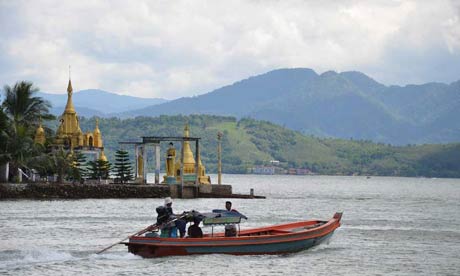
Just off the coast of southernmost Burma lies a collection of 800 islands – the Myeik (Mergui) Archipelago – most of which are uninhabited. Intrigued, Wanderlust editor Phoebe Smith set sail…
The fisherman eyed me suspiciously. Standing before him I must have looked a very odd sight; long boardshorts coloured grey with splashes of pink dripping with water, clashing nicely with my bright orange lifevest that seemed to be glowing in the dawn light.
Hein, my guide, spoke to him in Burmese and, from his hand gestures, I knew he was referring to the bartering package I was clutching in my hand; a black dry bag filled with five Thai beers. He held a basket out to me and motioned for me to drop the contents into it. Slowly, as the shiny cans of Leo bounced into the container, a wide smile spread over his face.
“We’re good,” said Hein. “They’re going to trade.”
It was an auspicious beginning to my Burma trip – especially given that I was travelling in an area not yet discovered by most travellers. Burma may have reopened its doors to tourists a couple of years ago, but this was the Myeik Archipelago, a smattering of wild islands in the Andaman Sea, which the government has only just begun issuing permits for a limited few to explore. A boat has to have been granted permission and all must take a qualified, approved Burmese tour guide – of which there are only a few.
I, along with six other curious travellers, had boarded a catamaran in Kawthuang, a small fishing town on the Burma/Thailand border. Despite already having a visa it took the best part of a two hours to clear immigration and be granted leave to set sail. But already the reward was far outweighing the hassle. En route to our first anchorage we’d passed a number of islands and every single one of them would easily be able to play paradise in a Bounty advert, giving us a tantalising introduction into what lay ahead. Most were covered with a thicket of dense trees which rumour has it hides an enticing array of wildlife – from tiger to wild boar, python to elephant – depending who you speak to.
However, all I had seen were sea eagles swooping over the sails and later, when we moored close to an island that boasted a runway strip of gold sand along its wooded perimeter, a school of sailfish passed by. But the sense of anticipation of what might happen, what we might see and experience, was palpable.
As the sun set, we watched the sky turn a pale shade of amber before the moon rose on the watery horizon and bathed the night sky with a pallid glow. That evening Hein talked us through everything we might experience over the next seven days. There was a hike up to the summit of a island peak; snorkelling along not one but three different sections of coral reef – one of which even he had not ventured to before; and, perhaps the one I was most excited about – a visit to the Moken village – home of the so-called sea gypsies.
All this was still swimming through my mind the next morning when we spied the cluster of fishing boats tied together a few hundred metres from our vessel. Hein thought we should try to barter with them for some seafood so he and I jumped into one of the kayaks and sped our way over the waves to their trio of huge wooden galleons.
Now on-board, with the offering of alcohol accepted, the men were filling my bag with squid, fish and what can only be described as a banquet of more than ten freshly caught crabs. They invited me to climb up to the top deck and inspect their fleet.
I made my way toward a rickety ladder, feeling it creak with each footstep, up to my bird’s eye view. From here I began taking photographs and watched as they too began snapping shots of me on their smartphones.
Hein signalled that our loot was ready, it was time to say goodbye. Shaking the captain’s hand I jumped back into the kayak, feeling like I’d taken the first step to becoming a bona fide sea dog. As we began our paddle back I felt a grin spread across my face uncontrollably as a thought suddenly occurred to me – this was only the start of my adventure…